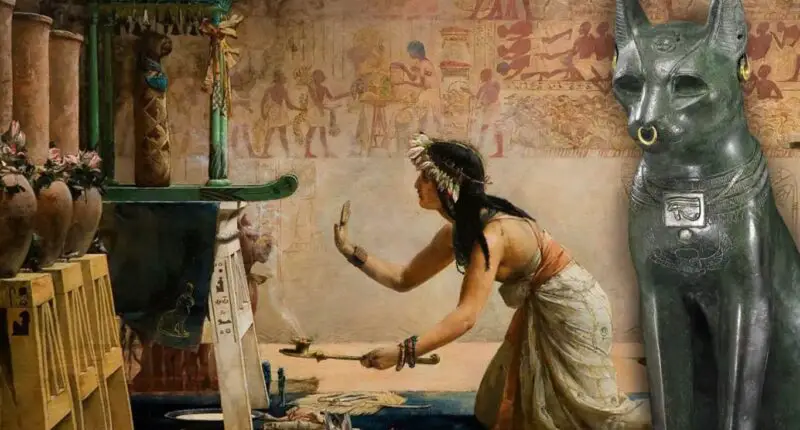Cats have been beloved pets for thousands of years, but in ancient Egypt, they were more than just domesticated animals. They were revered and worshipped for their perceived divine qualities, playing a significant role in the country’s mythology and religion. In this article, we will Exploring the Role of Cats in Ancient Egyptian Mythology, exploring the different roles they played and the gods and goddesses they were associated with. From the goddess of protection, Bastet, to the powerful lion-headed Sekhmet, cats held a special place in Egyptian culture that has lasted for millennia.
Exploring the Role of Cats in Ancient Egyptian Mythology
Role

For over 3,000 years, cats played an integral role in the social and religious practices of ancient Egypt. Various deities, including Mafdet, Bastet, and Sekhmet, were depicted with feline features, representing concepts such as justice, fertility, and power. The cat’s ability to kill venomous snakes and protect the Pharaoh earned them high praise, with remains found among funerary goods dating back to the 12th Dynasty. The Book of the Dead highlights the protective function of cats, where they symbolize the benefits of the sun for life on Earth, represented by Ra. During the New Kingdom of Egypt, cat-shaped decorations indicate a rise in popularity of the cat cult in daily life, often associated with the name of Bastet.
Bastet

She was a goddess in ancient Egyptian mythology, who was worshipped for her association with protection, fertility, and motherhood. She was often depicted in art and sculpture as a woman with the head of a domesticated cat, symbolizing her connection with felines. Cats were considered sacred animals of Bastet, and many temples throughout Egypt were dedicated to her worship. The cat was believed to embody the qualities that Bastet represented, such as grace, agility, and protection. As such, cats were kept in homes and revered for their association with the goddess. The worship of Bastet and cats played a significant role in ancient Egyptian culture and religion.
Ra

God of the sun Ra, who was worshiped and revered for his association with light, warmth, and life-giving energy. Ra was often depicted in art and sculpture as a man with the head of a falcon, symbolizing his power and connection to the sky. According to some versions of the myth, Ra was said to have created the first cat, which made the cat a sacred animal to the god. Cats were believed to can ward off evil spirits and protect their owners, which further elevated their status as a revered and respected animal in ancient Egyptian culture. As such, cats were often depicted in art and were sometimes mummified and buried alongside their owners. The belief in the protective powers of cats played an important role in the culture and religion of ancient Egypt.
Mafdet

In ancient Egyptian mythology, Mafdet was the goddess of justice and protection, who was revered and worshipped for her association with these concepts. She was often depicted in art and sculpture as a woman with the head of a cheetah or lynx, symbolizing her power and connection to these wild felines. Like Bastet, cats were believed to be the sacred animals of Mafdet, and many people kept cats in their homes as a symbol of protection. The belief was that cats could ward off evil and protect their owners from harm. The worship of Mafdet and her association with cats played an important role in the culture and religion of ancient Egypt, and her influence can still be seen in the depictions of cats in Egyptian art and literature.
Sekhmet

Sekhmet, an ancient Egyptian goddess, was worshipped for her association with war and destruction. In artwork and sculpture, she was typically portrayed as a woman with the head of a lioness, representing her ferocity and power. Like Bastet and Mafdet, other feline goddesses, cats were regarded as sacred animals of Sekhmet. They were often associated with her strength and aggression, as the cat’s ability to hunt and kill prey was seen as a reflection of Sekhmet’s destructive powers on the battlefield. The worship of Sekhmet and her connection with cats played a significant role in the culture and religion of ancient Egypt. Her influence can still be found in the depictions of felines in Egyptian mythology and art.
Conclusion
The role of cats in ancient Egyptian mythology was multifaceted and integral to the culture and religion of ancient Egypt. Cats were revered and worshipped as sacred animals, often associated with various goddesses such as Bastet, Mafdet, and Sekhmet. Their ability to protect their owners from harm, as well as their prowess in hunting and killing, was seen as a reflection of the divine power and influence of these feline deities. The worship of these goddesses and their association with cats can still be seen in Egyptian art and literature today. The enduring influence of cats in ancient Egyptian mythology is a testament to the significance of these animals in the lives and beliefs of ancient Egyptians.
Also Read: Rise and Fall of The Egyptian Empire: A tale of Glory and Tragedy



